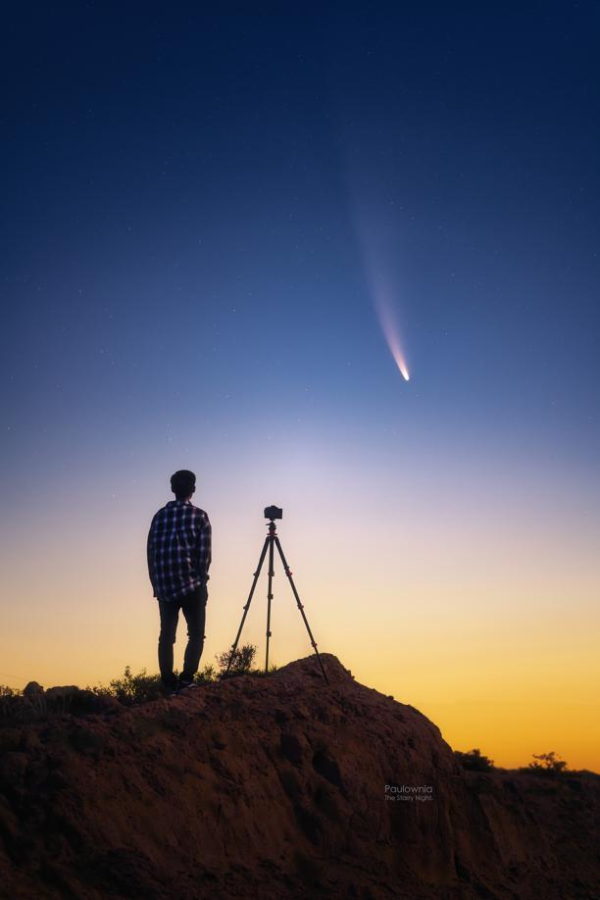Moon shot wins prize
Dong Shuchang from Northwest China's Ningxia Hui autonomous region captured the solar eclipse on June 21, 2020, in his photography work The Golden Ring, becoming the winner of the 2021 Astronomy Photographer of the Year competition in mid-September.

The Golden Ring, Dong Shuchang's award-winning image at the 2021 Astronomy Photographer of the Year competition. Photo provided to China Daily
Hosted by the Royal Observatory Greenwich, the competition received 4,500 entries from 75 countries and regions.

Dong Shuchang, a 21-year-old junior student from Ningxia Hui autonomous region, takes photos of the sky. Photo provided to chinadaily.com.cn
Dong's image also won in the competition's "our sun" category.
The Golden Ring shows the moon blocking out most of the solar disc and leaving only a thin ring of sunlight shining through.

Dong travels off the beaten trail to chase stars and take photos. Memorable moments include observing a comet in Yinchuan, Ningxia Hui autonomous region. Photo provided to China Daily
Dong started to prepare for the trip to take the shots toward the end of 2019.
"In fact, I had everything covered in my head," says the 23-year-old, adding that he figured all he had to do was open the camera and press the shutter.
However, that didn't go as he expected. The COVID-19 pandemic put a brake on his plans in early 2020. "All of a sudden, everything became uncertain."
Thanks to the effective pandemic control in China, Dong moved with his plan in the middle of last year. As he finally hit the road, it was still a rough ride. He and his friends encountered some problems on their way to Ngari prefecture in the Tibet autonomous region to take photos of the solar eclipse.

Dong travels off the beaten trail to chase stars and take photos. Memorable moments include observing a comet in Yinchuan, Ningxia Hui autonomous region. Photo provided to China Daily
When Dong and his friends finally reached their destination, the sky was blocked by thick clouds.
"You had to be there to feel the frustration of about 100 photographers who were ready and waiting for the solar eclipse," he says.
But magic seemed to happen. The clouds moved away and the sun came out. Dong clicked.
Through two different exposures, Dong superimposed two eclipse photos. "It made the image simple yet dynamic."

The Milky Way arches across the night sky above the Yarlung Zangbo Grand Canyon in the Tibet autonomous region. Photo provided to China Daily
Emily Drabek-Maunder, who is an astronomer at the Royal Observatory Greenwich, says: "Solar eclipses have been capturing the interest of humans for thousands of years across the world. This image demonstrates both the beauty and simplicity of an eclipse, but also the science behind this astronomical event.
"Our sun can still be seen as a ring circling the moon as it passes in front of the sun, and mountains on the lunar surface can be seen hiding some of this light on the lower right-hand portion of the image. This is a stunning achievement."
"Astronomy photography enables me to record details that are usually missed by the naked eye," Dong says.

Photo by Dong Shuchang/for chinadaily.com.cn
He adds that when he uses telephoto lens to take photos, he can see, for example, the details of the Milky Way, as well as its red, green and blue colors that "can be brought into sharp relief through photography".
Such photography prompted Dong to acquire knowledge of the field.
"I got to know how temperature and air composition can result in different star colors, such as blue and yellow that are shown in the images," he says.
"It is also thrilling when you can see something (in photos) in the great distance like the Andromeda Galaxy."

Photo by Dong Shuchang/for chinadaily.com.cn
He threw his hat in the ring of the 2019 Astronomy Photographer of the Year competition. "It was well-known to people in the circle, so I wanted to put my skills to test through it."
Dong's self-confidence got a shot in the arm after winning the best newcomer award with his work, Sky and Ground, Stars and Sand.

The photo Sky and Ground, Stars and Sand by Dong Shuchang wins him top honors at the Insight Investment Astronomy Photographer of the Year 2019 contest. Photo by Dong Shuchang/for chinadaily.com.cn
Dong says more than three years of chasing the stars has brought excitement and accomplishment in his life, although the process was often mixed with sweat and tears.
Sichuan province, and Tibet, Ningxia Hui and Xinjiang Uygur autonomous regions are ideal for star observation.
"They have less pollution and moisture, and more clear skies, which don't interfere with the clarity of the atmosphere," Dong says.

A crescent moon framed by the Shanghai World Financial Center. Photo provided to China Daily
In late September, Dong went on a photography trip, sponsored by the Chinese National Geography magazine, to Qomolangma, also known in the West as Mount Everest.
His breath was taken away by the biodiversity, including forest trees, tropical and meadow plants, snowy peaks, glaciers and moraine lakes in a valley 4,000 meters above sea level.
The stunning views of the giant mountain peaks turned pink by the sunrise made Dong forget his altitude sickness. "I will surely go back again."
Speaking about his future plan, Dong says he will explore new photography fields and better ways to integrate science and art.

 Yinchuan Wine-producing Area at the eastern foothills of Helan Mountains
Yinchuan Wine-producing Area at the eastern foothills of Helan Mountains A promising Sci & Tech center in NW China
A promising Sci & Tech center in NW China Party building stories in Yinchuan's Xixia district
Party building stories in Yinchuan's Xixia district